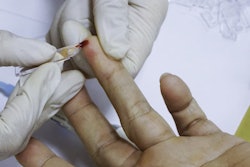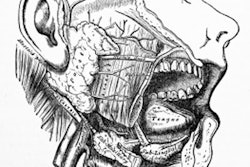
Endodontists and periodontists were slightly more accurate than general practitioners and oral and maxillofacial surgeons in evaluating suspicious oral lesions, according to a study in Quintessence International (July/August 2011, Vol. 42:7, pp. 575-577).
General practitioners correctly diagnosed only about half of the oral lesions they submitted for biopsy, while oral and maxillofacial surgeons and other specialists did slightly better, according to researchers from the Virginia Commonwealth University (VCU) School of Dentistry.
But the overall error rates across all groups were high enough to warrant the need for all excised lesions to be microscopically analyzed for histologic diagnosis, the study authors noted.
The researchers reviewed the biopsy reports of 976 tissue specimens submitted to VCU's oral and maxillofacial pathology department from January 2009 to January 2010 for the study and found that 43% of the diagnoses made by the submitting clinician were incorrect.
General practitioners misdiagnosed 45.9% of the oral lesions they submitted, oral and maxillofacial surgeons were wrong 42.8% of the time, endodontists were incorrect 42.2%, and periodontists had a 41.2% error rate.
Hyperkeratosis was misdiagnosed the most (16%), followed by focal inflammatory fibrous hyperplasia (10%), fibroma (8%), periapical granuloma (7%), and radicular cysts (6%). Malignant lesions had the lowest rate of incorrect diagnoses at 5.6%.
"The high percentage of clinical misdiagnosis found in this study, particularly of common conditions such as fibromas, periapical granulomas, and radicular cysts, emphasizes the importance of submitting all excised tissue for microscopic examination and histologic diagnosis," the study authors wrote. "The relatively high rate of clinical misdiagnosis of oral lesions biopsied and submitted for histologic diagnosis by dental practitioners suggests that there is probably an even greater rate of error occurring in clinical practice."
Surprised by the findings
Lead investigator Daniel M. Laskin, DDS, a VCU professor of oral and maxillofacial surgery, said he was surprised that some of the more common benign conditions were misdiagnosed.
"However, I was pleased that the number of cancerous lesions that were not recognized clinically was relatively low because it is these more serious conditions that give us the greatest concern," he told DrBicuspid.com.
Nadarajah Vigneswaran, BDS, DMD, a professor of diagnostic sciences at the University of Texas School of Dentistry at Houston, agreed that clinicians should have been able to tell the difference between such common lesions as fibromas, papillomas, or apical granulomas.
"There are certain very basic clinical findings that we assume that dentists know, things that are supposed to be clear-cut, and those diagnoses are not difficult," he told DrBicuspid.com.
“Any tissue removed by the general dentist should be sent for microscopic examination.”
— Daniel M. Laskin, DDS, Virginia
Commonwealth University
Most practitioners should have known what such lesions look like from seeing them in their patients, Dr. Vigneswaran noted.
"Conditions like fibroma, which is very common, is something most dentists would have often seen in practice and has a very classic pattern of nodules, so that's something that should not be confused with papillomas, which are basically a papillary type of lesion," he said. "One is an epithelial lesion and the other is with connective tissue, so there are surface changes which distinguish these two lesions. So that's something that surprised me."
General practitioners can do simple biopsies, Dr. Laskin said, but he advises them to send the specimens to a lab for verification.
"If they do not feel comfortable doing a biopsy in a particular case, it should then be referred to an oral and maxillofacial surgeon," he said. "The important lesson is that any tissue removed by the general dentist should be sent for microscopic examination. In that way, the dentist confirms whether the clinical diagnosis was correct and thus becomes a better diagnostician."
The most important thing, according to Dr. Vigneswaran, is knowing which lesions should be biopsied so patients with malignancies can be correctly diagnosed and treated quickly.
"There are a lot of other diseases where patients unnecessarily go through a lot of difficulty and expense because the lack of biopsy has delayed the diagnosis," he explained.
For example, many dentists incorrectly send patients with lichen planus to their family doctor for treatment, Dr. Vigneswaran said, because they lack the training to detect them properly.
"We [oral pathologists] see again and again patients presenting with mucosal ulcerations and erosions that are hurting," he said. "Patients assume this is a problem the dentist is not supposed to deal with, but the main problem is many students or dentists don't have adequate training to diagnose oral mucosal diseases."
Family doctors often assume ulcers in the mouth are typically herpes, Dr. Vigneswaran said, and they usually prescribe antibiotics.
"The patient doesn't get better, and they go around to different doctors, sometimes the [emergency room], and it could have all been solved if somebody had done a biopsy or the dentist had referred them to an oral surgeon or oral pathologist," he said.
Such specialists could specifically diagnose whether it's cancer or mucocutaneous ulcerative diseases, including lichen planus, mucous membrane pemphigoid, and pemphigus vulgaris, Dr. Vigneswaran explained. "These mucocutaneous diseases present as diffuse mucositis with chronic ulcers, and they need a biopsy for a definitive diagnosis and appropriate treatment," he noted.
One of his patients ended up going to the emergency room three times before he was finally diagnosed with lichen planus.
"For some patients, it can be a very severe ulceration, and they cannot eat, and they have a very tough time," Dr. Vigneswaran said. "Unfortunately, the patient doesn't know who they should go to for treatment, and sometimes even the healthcare providers don't know who they should refer the patient to."
When to refer biopsies out
Dentists who suspect lesions may be malignant should let a specialist do the biopsy, Dr. Laskin said.
"Although it is important for general dentists to always examine their patients for the presence of oral lesions, it is not always best for them to do the biopsy if they think the lesion may be cancerous because they will not be doing the definitive treatment in such cases," he explained. "Cancers need wide excision, and by removing the part that is clinically visible, it makes it more difficult for the treating doctor, who then has not seen the lesion, to determine the proper procedure to be done for the patient."
While dentists may be concerned about unnecessarily worrying their patients, Dr. Laskin said it's worth the effort.
"When patients hear the word 'biopsy,' they generally think that the dentist is concerned that the lesion may be a cancer," he noted. "However, even when the dentist feels that the lesion is benign on a clinical basis, there is always the possibility that the diagnosis may not be correct and microscopic confirmation is necessary. It is worth the short period of worry the patient may undergo, and the cost involved, to be assured that the clinical diagnosis is correct."
Most medical insurance doesn't pay for biopsies if they are done by the dentist, Dr. Vigneswaran noted, so patients often have to pay for the evaluations, which run $300 to $400.
Dentists should be careful to document when they refer patients for biopsies, Dr. Vigneswaran advised, and they should follow up to be sure that it's been done.
"Many times general dentists aren't convincing enough to explain to the patient why a biopsy is necessary, so compliance may not be as good," he noted. "Then when they pop up with cancer, they'll say, 'You never told me I needed that.' If I'm going to be a good practitioner, I type a letter and give it to the patient and mail a copy to the oral surgeon or whomever I'm going to refer them to."



















